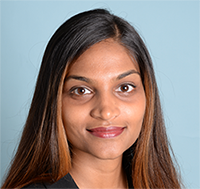Ophthalmology training often involves an increasingly specialized path, but one career track lets you bridge the gap between medicine and science, regardless of subspecialty. For ophthalmologists who want to see patients and make cutting-edge discoveries that improve eye care and prevent blindness, becoming a clinician-scientist presents an ideal career track.
What Is a Clinician-Scientist?
Clinician-scientists are medical doctors who have significant clinical and research training. They combine the medical care of patients with their own research to improve the management and treatment of eye disease.
“They play a vital role in ophthalmology by helping us to understand the basic pathophysiology of eye diseases,” said Esther Bowie, MD, chair-elect of the Association for Research in Vision and Ophthalmology Member in Training Committee. “They also help make bench research a practical reality for patients.”
All subspecialties within ophthalmology benefit from this translational research. Some prominent examples include innovations in anti–vascular endothelial growth factor (VEGF) therapy; the understanding of normal tension glaucoma, genetics and controlled-release medications; and other advances in refractive, cornea and cataract surgery.
“In order to bring these monumental improvements to practice, clinician-scientists have to take incremental steps with the help the medical industry, research teams and patient volunteers,” said ARVO MIT Committee member Natasha Nayak, MD. “So they really have to be inquisitive, collaborative and willing to balance the demands of ‘wearing two hats.’”
Where Clinician-Scientists Work

Dr. Nayak.
Clinician-scientists practice across a large spectrum of settings. Some work as members of a lab such as the National Institutes of Health, while others serve as faculty at an academic institution or employees of pharmaceutical or biotechnology companies.
However, a clinician-scientist’s research skills apply to any position that prioritizes quality improvement, epidemiology or outcomes-based research.
“A private practitioner, for example, can play an integral role in clinical trials and surgical innovation and is more than capable of being a clinician-scientist,” said Dr. Nayak. “The clinician-scientist’s niche really boils down to a combination of their passion and the resources that are available in their particular practice setting.”
How to Become a Clinician-Scientist
Ophthalmologists take many routes into clinical science. A more traditional approach involves obtaining a medical degree as well as a PhD. You can also pair your medical degree with a secondary degree such as an MPH (master of public health) or a more specific master’s degree. Doing so can provide additional support for grant applications and help you highlight your various skills.
Institutions like the Heed Ophthalmic Foundation, the Howard Hughes Medical Institute and the Doris Duke Charitable Foundation also offer non-degree programs with structured mentorships and funding for postgraduate study in the ophthalmic sciences.
“Everyone carves their own path,” said Dr. Nayak. “My advice is to seek out mentors and ask them about what ‘forks in the road’ and ‘slippery slopes’ they’ve encountered during their careers.”
When to Commit
“You don’t have to make an early commitment,” said Dr. Bowie, “because you may not be sure what path you want to follow.”
Nevertheless, you should prioritize some things during your early training, if you are at all interested in becoming a clinician-scientist.
- Get involved in as many research projects as possible.
- Identify a research mentor and think about what you want to gain from that relationship and what you can contribute.
- Meet as many people as possible who can help you achieve your goals.
- Approach successful clinician-scientists and ask them what skills you should acquire.
Doing so, said Dr. Nayak, will help you throughout your career regardless of whether you decide to become a clinician-scientist or not. Conducting your own research, for example, will help you:
- Learn how to critically appraise scientific literature.
- Become an expert in a specific niche.
- Understand the basics of institutional review-board approval.
- Master different statistical methodologies.
- Design better studies in the future.
“Once you do commit to becoming a clinician-scientist,” said Dr. Nayak, “it’s important to identify ways to increase your skillset and explore your niche.” She recommends:
“Lastly, and perhaps most importantly,” she said, “be passionate but try not to overcommit — make sure not to bite off more than you can chew during training!”
Learn More
Make sure to attend Mid-Year Forum 2017, where you can hear ARVO President Emily Chew, MD, discuss clinician-driven science during the L.E.A.P. Forward program. Dr. Chew is the National Eye Institute’s deputy clinical director and deputy director of its Division of Epidemiology and Clinical Applications.
YOs will also be able to network with senior clinician-scientists during AAO 2017, Nov. 11-14 in New Orleans. The Academy’s YO committee and ARVO’s MIT committee will jointly sponsor an event where YOs can network with senior clinicians and ARVO leaders in an informal environment.
And for those early-career clinicians and researchers who want to learn from and network with leaders in the field in a casual setting, be sure to check out ARVO’s annual meeting, May 7 to 11, in Baltimore, Md.
* * *
About the author: Mike Mott is a former assistant editor for EyeNet Magazine and contributing writer for YO Info.